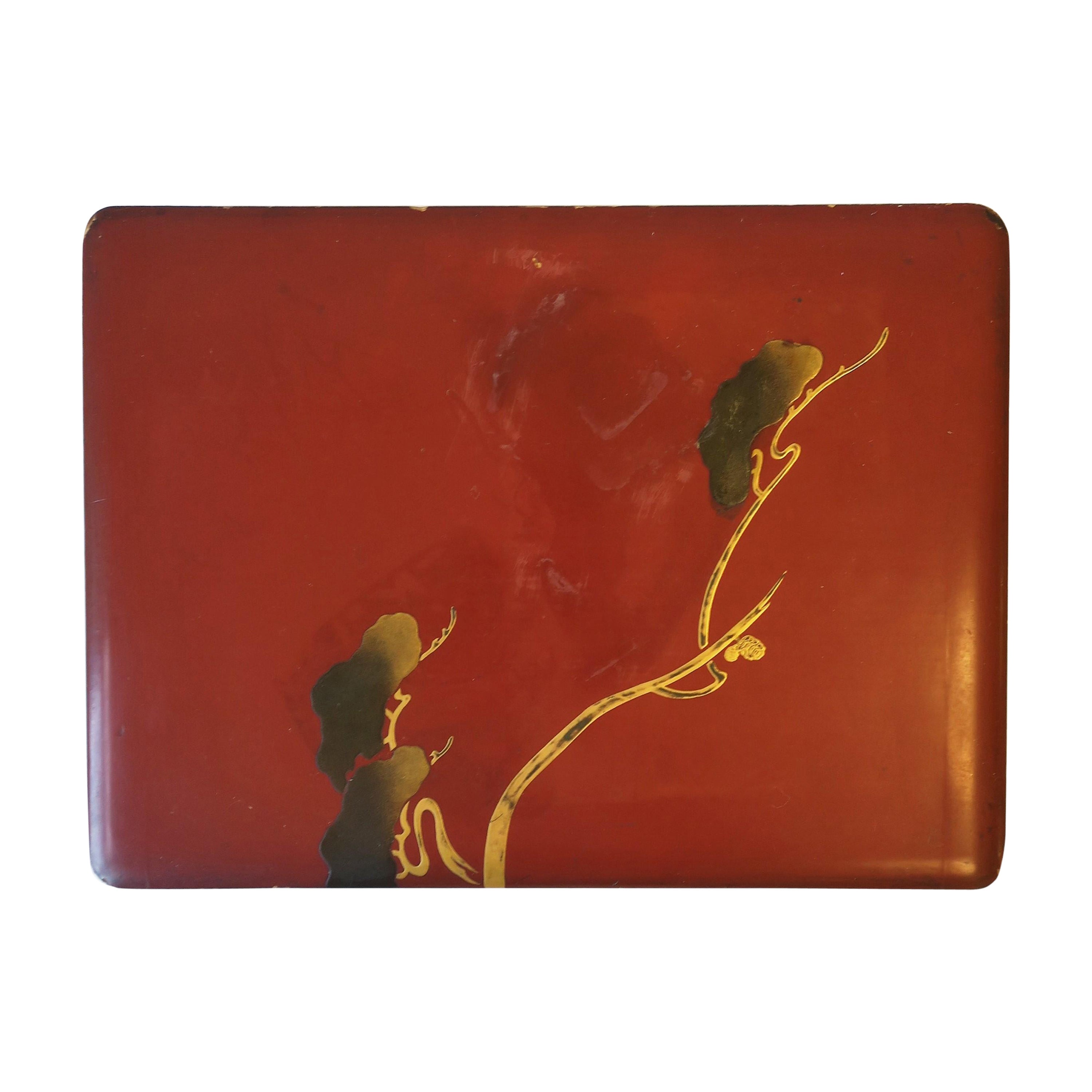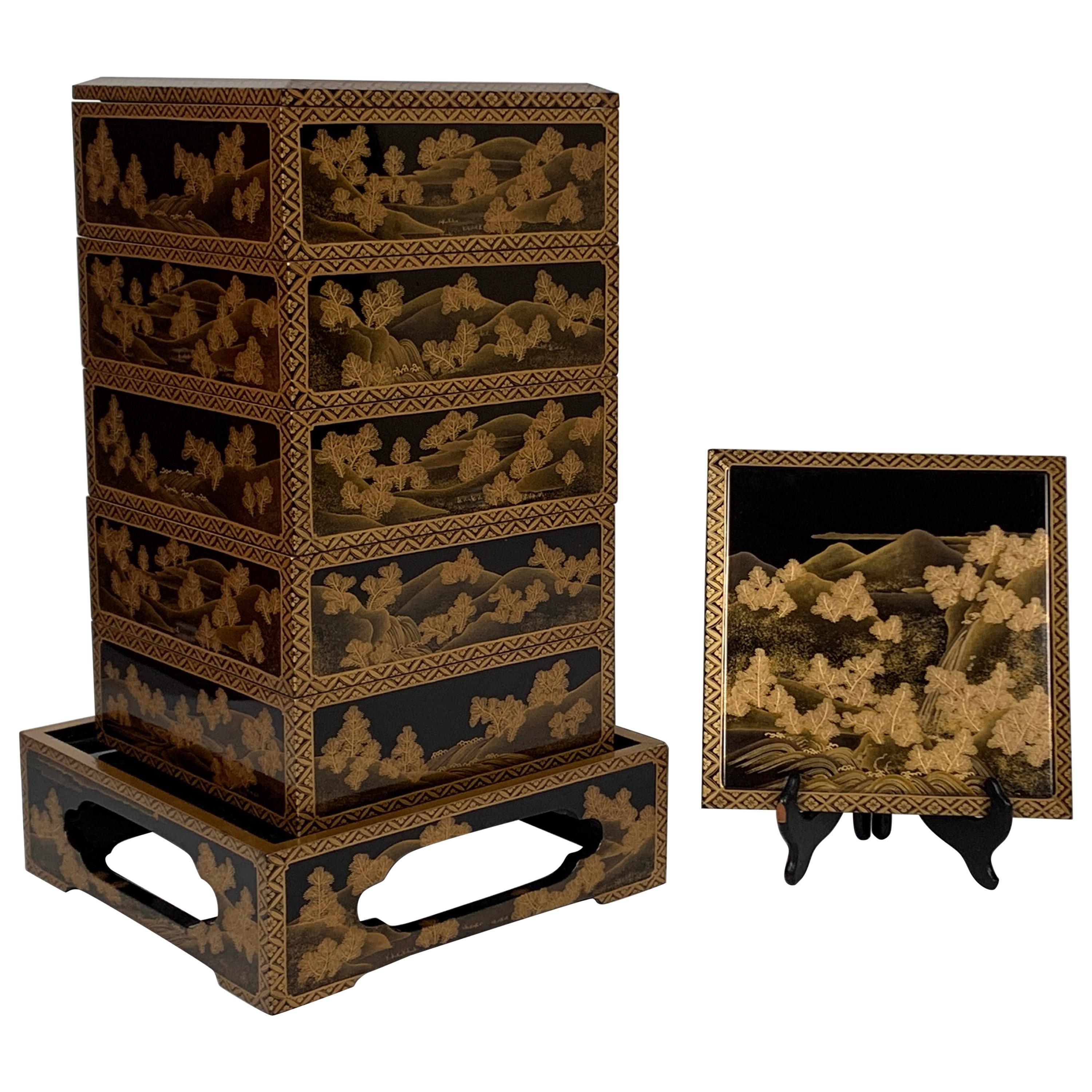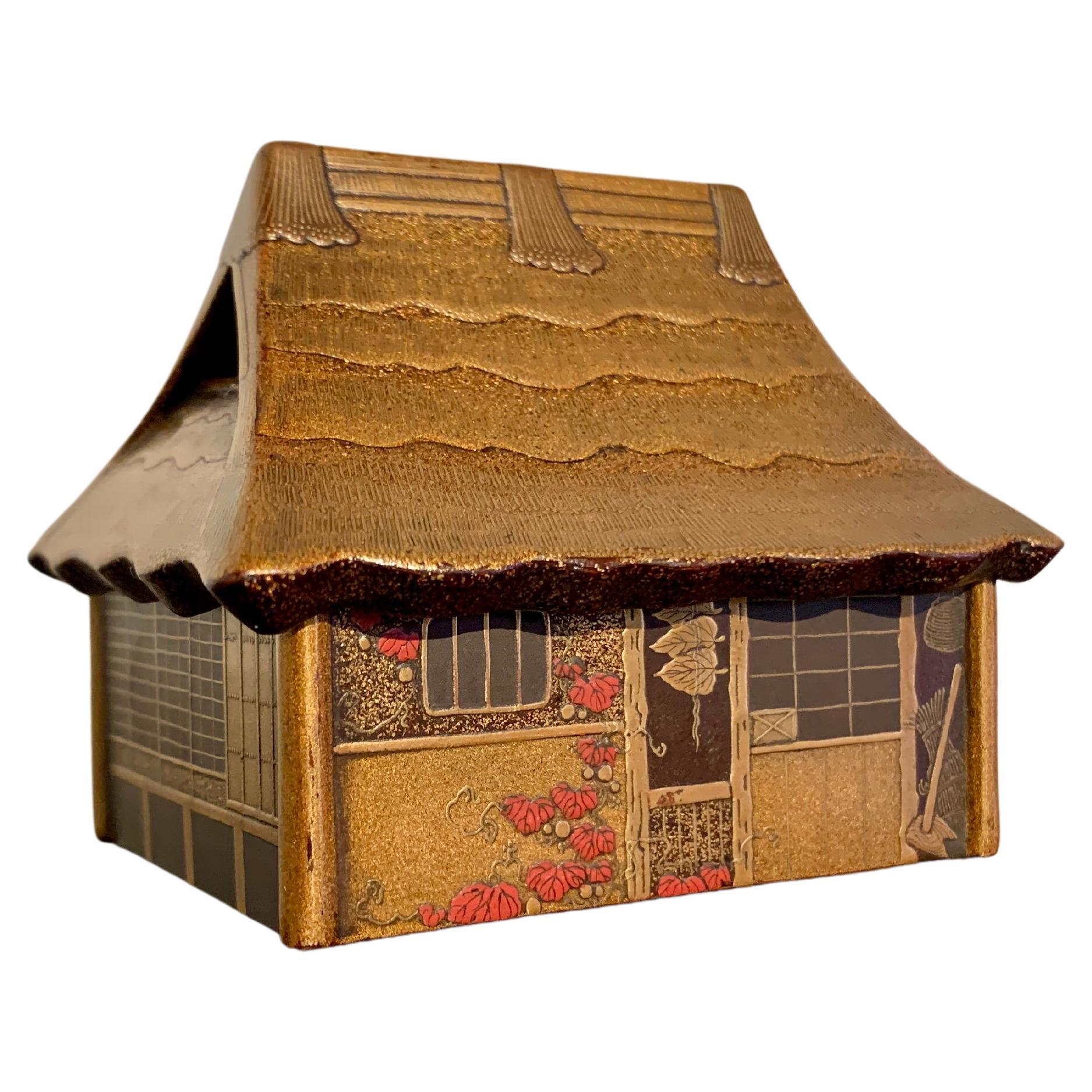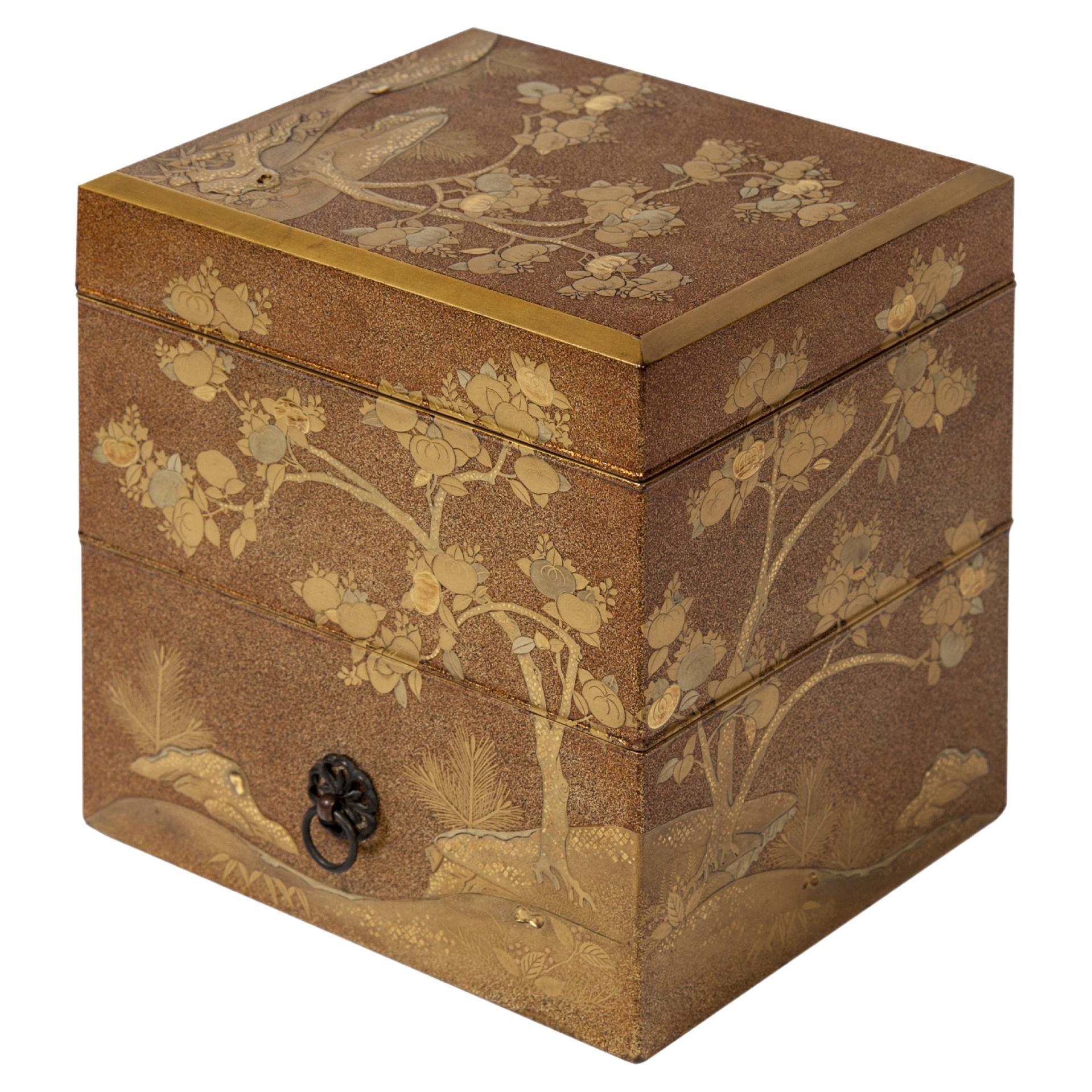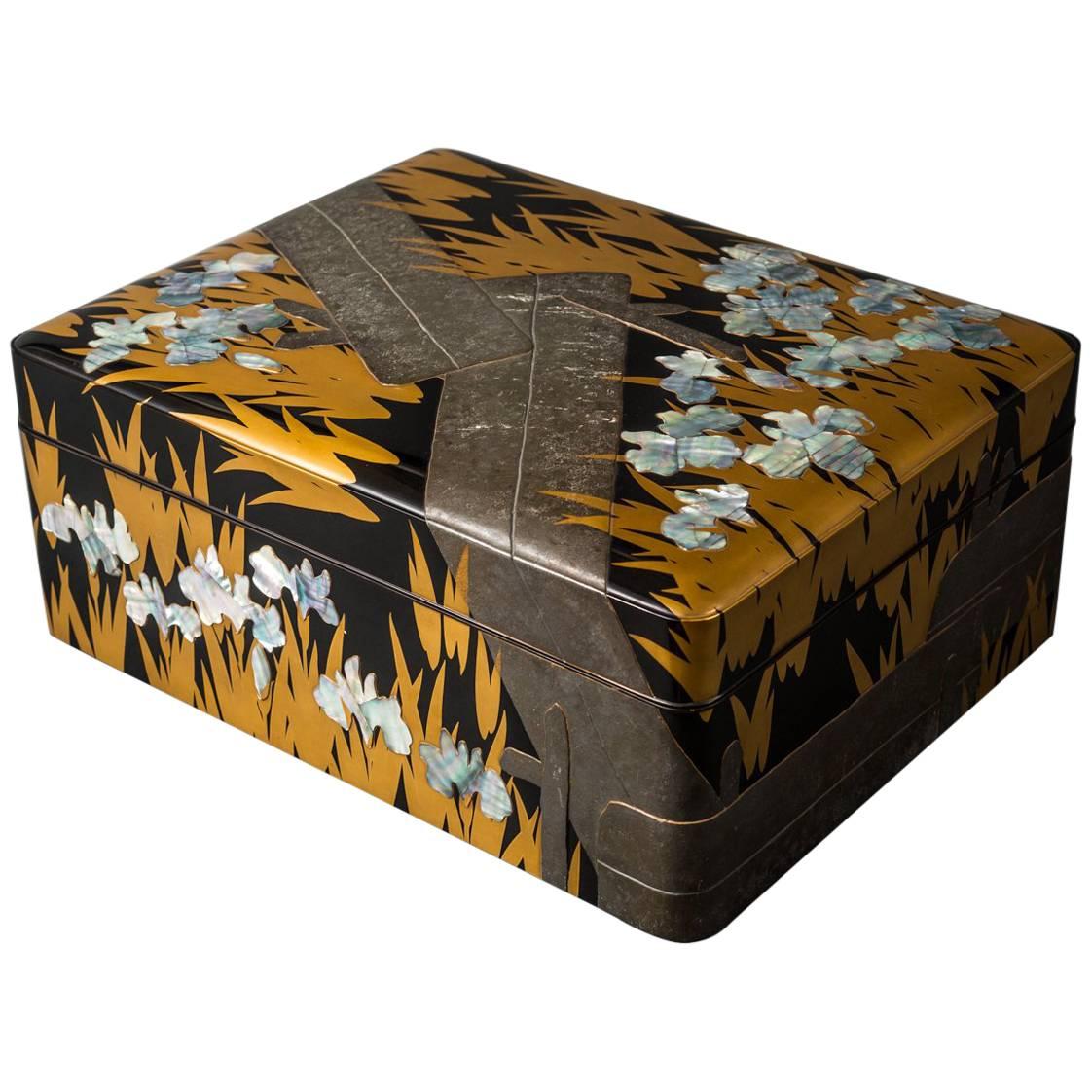Items Similar to Japanese Lacquer Box
Want more images or videos?
Request additional images or videos from the seller
1 of 7
Japanese Lacquer Box
About the Item
This exquisite Meiji-period lacquer document box known as a ryoshibako showcases the meticulous artistry of maki-e, a technique of raised lacquer decoration. Adorned with gold and vibrant hues, it features emblems representing the four esteemed classes of Edo society: samurai and warriors, farmers, craftsmen and merchants. Each class is symbolized through intricately rendered designs, including a bow on a stand for the warriors, a basket of leaves for the farmers, calligraphy tools for the craftsmen and a set of scales and abacus for the merchants. The box's exterior is a sophisticated black ground, achieved through shibonuri, a technique mimicking a woven texture.
The creation of a lacquer box such as this would have been an incredibly time-consuming process; the art form is considered among the most labor-intensive in the world and requires an exceptional level of finesse. Intricately detailed lacquer boxes such as this reveal the mastery of their maker and the storied tradition of Japanese craftsmanship.
Circa 1870
7 1/4“ high x 17 3/4” wide x 13 3/4“ deep
- Dimensions:Height: 7.25 in (18.42 cm)Width: 17.75 in (45.09 cm)Depth: 13.75 in (34.93 cm)
- Style:Meiji (Of the Period)
- Materials and Techniques:
- Place of Origin:
- Period:
- Date of Manufacture:Circa 1870
- Condition:
- Seller Location:New Orleans, LA
- Reference Number:
About the Seller
5.0
Recognized Seller
These prestigious sellers are industry leaders and represent the highest echelon for item quality and design.
Established in 1912
1stDibs seller since 2010
93 sales on 1stDibs
Typical response time: 7 hours
- ShippingRetrieving quote...Ships From: New Orleans, LA
- Return PolicyThis item cannot be returned.
More From This SellerView All
- Japanese Lacquer TrayLocated in New Orleans, LAAs beautiful as it is practical, this Japanese Meiji-period lacquered tray is distinguished by its exceptional craftsmanship. It exhibits a phenomenal artistry as the entire tray is ...Category
Early 20th Century Japanese Meiji Lacquer
MaterialsLacquer
- Japanese Lacquer TrayLocated in New Orleans, LAHailing from illustrious Meiji-period Japan, this lacquer tray showcases the mastery of Japanese craftsmen. Precious materials are precisely inlaid in the lacquer base, creating an a...Category
Antique Late 19th Century Japanese Meiji Lacquer
MaterialsSilver
- Japanese Lacquer and Gold TrayLocated in New Orleans, LAThis Meiji-period lacquer tray represents the mastery of Japanese craftsmen in the art of lacquer work. Precious materials are precisely inlaid in the lacquer base, creating a highly...Category
Antique Late 19th Century Asian Meiji Lacquer
MaterialsGold
- Japanese Lacquer Tray With CardsLocated in New Orleans, LAThis Meiji-period lacquer tray represents the mastery of Japanese craftsmen in the art of lacquer work. Precious materials are precisely inlaid in the lacquer base, creating a highly...Category
Antique Late 19th Century Japanese Meiji Lacquer
MaterialsGold
- Chinese Cinnabar Lacquer CuspidorLocated in New Orleans, LAThis intriguing Chinese zhadou is intricately carved of fine cinnabar lacquer. A work of exceptional artistry, this covered bowl is adorned with an intricately carved floral motif on all surfaces, including the cover and the wide rim. Also known as a cuspidor or spittoon, this rare container would have been used by members of the imperial family and scholar- officials at the court. Carved during the Kangxi period (1662-1722), this charming piece exhibits the high detail and charm associated with items from that period, making it a true treasure, Early 18th century (Kangxi dynasty) Measures: 6 ¼” wide x 3 ¼” high Cinnabar has been revered for its color all over the world. It has been found in the royal burial chambers of the Mayas, in the rituals of India, and in the ruins of ancient Greece and Rome. In China, cinnabar and gold were the two most important elements in alchemy. Mined since the Neolithic Age, cinnabar is the ore of mercury, and as such, it can be incredibly toxic, especially when mining. In fact, during the Roman Empire, miners at Spain’s Almadén mine in Spain were frequently exposed to mercury fumes, and the subsequent, often fatal, sickness was considered an occupational hazard. The most popular known use of cinnabar is in Chinese carved lacquer-ware, a technique that is believed to have originated in the Song Dynasty, in which cinnabar is ground to a powder and added to clear lacquer. As with mining, there was inherent danger of mercury poisoning for those who carved the lacquer, as mercury was also released into the air when artisans ground the pigments. Most antique cinnabar...Category
Antique 18th Century Chinese Other Lacquer
MaterialsLacquer
- Edo-Period Lacquered JingasaLocated in New Orleans, LAComplete with a lacquered surface and original silk straps, this Japanese Edo-period traveling hat, or jingasa, first emerged during the illustrious period between 1603 and 1868, a t...Category
Antique 19th Century Asian Edo Lacquer
MaterialsSilk
You May Also Like
- Japanese Lacquer BoxLocated in New York, NYA Japanese red burgundy, gold and black lacquer box with round corners and silk cloth interior lining, circa early-20th century, 1920s, Japan. Box was desi...Category
Early 20th Century Japanese Decorative Boxes
MaterialsWood, Silk
- Japanese Maki-e Lacquer Stacking Box, Jubako, Meiji Period, JapanLocated in Austin, TXA fine and impressive Japanese gold maki-e decorated black lacquer five-tier jubako with presentation tray, two lids, and the original tomobako storage box, Meiji period, late 19th c...Category
Antique Late 19th Century Japanese Meiji Lacquer
MaterialsLacquer
- Large Japanese Lacquer Document Box, Ryoshibako, Edo/Meiji period, JapanLocated in Austin, TXA large and magnificently decorated Japanese lacquer document box, ryoshibako, signed Umeboshi/Baikyo, late Edo or early Meiji Period, mid 19th century, Japan. The large document box, ryoshibako, of tall, rectangular shape with rounded corners, and fitted with an inrobuta (flush-fitting) cover with beveled edges. The exterior of this exquisite box is decorated all over with fifteen different raised reserves shaped as uchiwa (paddle) fans against a lush and intricate krikane ground imitating shagreen. The uchiwa shaped reserves all of takamaki-e, and exquisitely painted with designs of animals, flowers, and landscapes in silver, gold, maki-e, hiramaki-e, and takamaki-e, with kirikane, nashiji, and polychrome embellishments, upon gold lacquer fudame grounds. The interior of the lid is nothing short of spectacular, featuring a large design of a magnificent and beautifully detailed rooster and hen with chicks gathered around a lazy stream. Large stalks of chrysanthemum bloom behind them. All against an ethereal nashiji ground. The cover of the box features five reserves: 1. Three minogame (turtles with long tails), symbolizing longevity 2. "Narihira Crossing the Sumida" from The Tales of Ise...Category
Antique 1860s Japanese Meiji Lacquer
MaterialsSoftwood, Lacquer
- Japanese Lacquer House Shaped Incense Box, Kogo, Meiji Period, JapanLocated in Austin, TXA delightful and intricately decorated lacquer box for storing incense, kogo, in the form of a traditional farm house, Meiji period (1864 - 1912), late 19th century, Japan. The kogo, or small box for storing incense, takes the whimsical form of a traditional Japanese home, minka, with the removable high, thatched roof serving as the cover for the box. The exterior of the home has been painstakingly decorated in maki-e lacquer against a matte black lacquer ground. Traditional shoji doors, bamboo blinds...Category
Antique Late 19th Century Japanese Meiji Lacquer
MaterialsLacquer
- Japanese Lacquered Tebako 'Box'Located in PARIS, FRTebako box with three compartments in golden and nashi-ji lacquer, decorated with golden, red, and kirigane lacquer, golden persimmon tree leaves, among rocks. The compartments are of increasing size from the top. The decoration is in continuity. Persimmon has been cultivated in southern China for more than 2500 years and is believed to have been introduced to Japan in the 8th century. The veneer is a tree with very hard wood, similar to ebony. According to a legend, one specimen survived the atomic bombing of Nagasaki on August 9, 1945, close to the epicenter. It is therefore in Japan a symbol of strength and longevity. It is also the national fruit of the country. It is eaten as a traditional dish during New Year's Day celebrations. Tebako literally means "portable box...Category
Antique 1860s Japanese Lacquer
MaterialsLacquer
- Japanese Lacquer Letter BoxLocated in Hudson, NYGold and shell marsh irises with pewter walkway wrapping around box. Korin style subject matter, nashiji ground interior and bottom with artist signature inside the lid. Signature re...Category
Antique Late 19th Century Japanese Lacquer
MaterialsGold, Pewter
Recently Viewed
View AllMore Ways To Browse
Japanese Lacquer Art
Japanese Black Lacquer Box
Japanese Lacquer Art
Chinese Enamel And Carved Lacquer
Takasago Couple
Lacca Giapponese
Negoro Nuri
Giant Silver Tray
Black And Gold Lacquer Chinese Miniature Chests
Japanese Ojime Beads
Metal Netsuke
Japanese Meiji Period Silver Kodansu
Jo Nagasaki
Indonesian Dowry Chest
Chinese Export Black Lacquer With Hand Painted Scene
Suzuri Bako
Lacquerware Burmese Tray
Antique 18th Century Paving Stones
